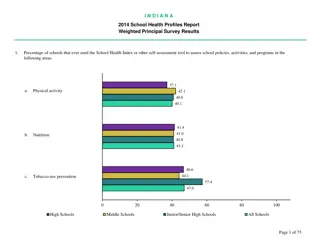Dr Digvijay Sharma School of health Sciences
Market segmentation is crucial in marketing to target specific consumer groups effectively. Learn about the importance, examples, and types of market segmentation to enhance your marketing strategies.
Download Presentation

Please find below an Image/Link to download the presentation.
The content on the website is provided AS IS for your information and personal use only. It may not be sold, licensed, or shared on other websites without obtaining consent from the author.If you encounter any issues during the download, it is possible that the publisher has removed the file from their server.
You are allowed to download the files provided on this website for personal or commercial use, subject to the condition that they are used lawfully. All files are the property of their respective owners.
The content on the website is provided AS IS for your information and personal use only. It may not be sold, licensed, or shared on other websites without obtaining consent from the author.
E N D
Presentation Transcript
Dr Digvijay Sharma School of health Sciences
Definition Market segmentation is the process of dividing up mass markets into groups with similar needs and wants.[1] Market segmentation is a marketing term that refers to aggregating prospective buyers into groups or segments with common needs and who respond similarly to a marketing action. Market segmentation enables companies to target different categories of consumers who perceive the full valueof certain products and services differently from one another.
The Importance of Market Segmentation Market segmentation can help you to define and better understand your target audiences and ideal customers. If you re a marketer, this allows you to identify the right market for your productsand then target your marketing more effectively. Similarly, publishers can use market segmentation to offer more precisely targeted advertising options and to customize their content for different audience groups.
Example Say, for example, you re a marketerwho s advertising a new brand of dog food. You could split an audience into segments based on whether they have a dog. You could then segment that audience further based on what kind of dog they have and then show them ads for food formulated for their dog s breed. A publisher could use this same information to show content about dogs to people who have or like dogs.
Market segmentation allows you to target your content to the right people in the right way, rather than targeting your entire audience with a generic message. This helps you increase the chances of people engaging with your ad or content, resulting in more efficient campaigns and improved return on investment (ROI).
Types of Market Segmentation There are the four main methods of market segmentation. 1.Demographic Segmentation 2.Behavioural Segmentation 3.Geographic Segmentation 4.Psychographic Segmentation
1. Demographic Segmentation Demographic segmentation is one of the most common forms. It refers to splitting up audiences based on observable, people-based differences. These qualities include things like age, sex, marital status, family size, occupation, education level, income, race, nationality and religion. Combining demographic segmentation with other types can help to narrow down the market even more. One benefit of this kind of segmentation is that the information is relatively easily accessible and low-cost to obtain. Some products are targeted explicitly towards a specific demographic. One personal care company, for example, might make two deodorant products one labeled as men s deodorant and one labeled as women s deodorant. Automotive companies often segment their audience by income and market different makes and models of cars to each segment. One company may have a luxury brand, an economy brand and a mid-range brand.
There are numerous ways to gather demographic data. One way is to ask your customers directly. This can be time-consuming, but getting the information directly from customers will help ensure its accuracy. In this route one need to be careful to be respectful in how you ask and give customers sufficient response options so you get accurate results. You may also be able to obtain demographic data directly from customers by looking at social media and other online profiles where they may provide information about themselves. You can also get demographic from second-party and third-party data providers including marketing service providers and credit bureaus. Public records, such as those kept by the U.S. Census Bureau and the U.S. Postal Service, can also provide useful information. Collecting this data in a data management platform (DMP) will help you to organize it and use it to target your marketing campaigns or content personalization efforts.
2. Behavioral Segmentation We also segment market based on consumers behaviors, especially regarding product. Dividing your audience based on behaviors they display, allows you to create messaging that caters to those behaviors. Many of the actions you might look at relate to how someone interacts with your product, website, app or brand.
Types of behaviors Online shopping habits: You might consider a users online shopping habits across all sites, as this may correlate with the likelihood they will make an online purchase on your website. Actions taken on a website: You can track actions users take on your online properties to better understand how they interact with them. You might look at how long someone stays on your site, whether they read articles all the way to the end, the types of content they click on and more. Benefits sought: This refers to the need a customer is trying to meet by purchasing a product.
Usage rate: You can categorize users based on usage rate. Your messaging will be different depending on whether someone is a heavy user, medium user, light user or non-user of your product. Loyalty: After using a product for some time, customers often develop brand loyalty. You can categorize customers based on how loyal they are to your brand and tailor your messaging accordingly. Behavioral data is useful because it relates directly to how someone interacts with your brand or products. Because of this, it can help you market more effectively to them. You can collect this data through various sources including cookies placed on your website, the purchase data in your customer relationship management (CRM) software and third-party datasets.
3. Geographic Segmentation Geographic segmentation, splitting up your market based on their location, is a basic but highly useful segmentation strategy. A customer s location can help you better understand their needs and enable you to send out location-specific ads. There are several kinds of geographic segmentation. The most basic is identifying users based on their locations such as their country, state, county and zip code. You can also identify consumers based on the characteristics of the area they live in, such as its climate, the population density and whether it s urban, suburban or rural. Identifying characteristics can require you to get more specific since one county could have rural, suburban and urban areas.
Dividing a market according to location is critical if you need to target an ad to people in a specific area, such as if you re advertising a small local business. It can also be useful if you re targeting a broad area because it enables you to tailor your messaging according to regional differences in language, interests, norms and other attributes as well as the differing needs of people in different regions. You may need to change the language your messaging depending on the region you re targeting. People who live in different countries may also have different interests. Baseball is very popular in the United States, for example, while cricket is more popular in India. If you re marketing sports equipment or publishing sports articles, you will want to take these different preferences into account. Companies can also consider different needs in different regions. A clothing company, for instance, will show ads featuring warmer clothing to people living in cooler climates and show the opposite to people living in warmer climates.
4. Psychographic Segmentation Psychographic segmentation is similar to demographic segmentation, but it deals with characteristics that are more mental and emotional. These attributes may not be as easy to observe as demographics, but they can give you valuable insight into your audience s motives, preferences and needs. Understanding these aspects of your audience can help you to create content that appeals to them more effectively. Some examples of psychographic characteristics include personality traits, interests, beliefs, values, attitudes and lifestyles.
If you find that members of a demographic segment are responding differently to your content, you might want to add in some psychographic information. While demographics provide the basic facts about who your audience is, psychographics give you insight into why people decide to purchase or not purchase your product, click on or ignore your ad and otherwise interact with you.
Say youre a furniture and home decor company, and you have a market segment consisting of newlyweds in their 20s and 30s with a household income above $60,000. Some members of this segment are converting, while others are not. When you add psychographic information into the mix, you may find that people that purchase your products often value community and friendships and are environmentally conscious. Based on this information, you could create ads that show people entertaining friends in their home and emphasize the environmentally friendly attributes of your brand.
You can collect this data in many of the same ways you can gather demographic data. You can ask your existing customers for this information using surveys. You can also look at the way people interact with your website and see what types of content they engage with, which gives you insight into their interests and preferences. You can also supplement your first-party data with second-party and third-party data.
Other Methods of Market Segmentation There are also many other strategies you can use, including numerous variations on the four main types. Here are several more methods you may want to look into.
Value segmentation: Some businesses will split up a market based on the transactional worth of their customers how much they re likely to spend on their products. To determine a customer s transactional worth, you can look at previous purchase data such as how many purchases they make, how often they make purchases and the value of the items they purchase.
Firmographic segmentation: Business-to-business (B2B) companies may use firmographic segmentation to divide up the businesses in a market. This is similar to demographic segmentation with individual consumers but instead looks at the characteristics of companies that may become customers. Examples of data to look at include industry, revenue, number of employees and location.
Generational segmentation: Businesses may segment consumers by generation and group them into categories that include Gen Z, Millenials, Generation X, Baby Boomers and the Silent Generation. These generations are believed to share certain preferences, behaviors, personality traits and beliefs. Of course, not every member of a generation is the same, but generational segmentation can give you some additional insight into your audience.
Lifestage segmentation: You can also segment your market into groups based on where they are in their lives. Going to college, getting married and having children are examples of key life events to consider. People at different stages of life need different things. For instance, soon-to-be college students may need apartment furniture. New parents will be looking to purchase baby food.
Seasonal segmentation: Similarly to how people buy different products in different periods of their lives, people also buy different items at different times of the year. Major holidays such as Christmas and Hanukkah also significantly impact purchasing behaviors.
Benefits of Market segmentation 1. Improves Campaign Performance Market segmentation can help you to improve the performance of your marketing campaigns by helping you to target the right people with the right messaging at the right time. Segmentation enables you to learn more about your audience so you can better tailor your messaging to their preferences and needs.
2. Informs Product Development Market segmentation can also help companies to develop products that better meet the needs of their customers. You can create products to appeal to needs your main market segment may have and develop different products tailored to different parts of your customer base. Say, for instance, you run an automotive company, and your primary market segment is middle-class families. You would likely design your car with lots of seating, leg room and space to accommodate a family with multiple kids. You would also create mid-range priced vehicles.
3. Reveals Areas to Expand Market segmentation can also help businesses to identify audience segments that they are not currently reaching with their marketing efforts and then expand into new markets. When you look at your audience data, you might discover interests that you didn t realize your customers had. For example, a company might make the majority of their sales in physical stores. When looking at behavioral data, they might see that many of their customers like to shop online. Based on this information, they could then either open an online store or stat advertising their online marketplace more.
4. Improves Business Focus Market segmentation can also help businesses to focus their efforts, which enables them to establish a brand identity and specialize in a particular type of products. A brand that tries to appeal to everyone in their marketing will come off as generic and unmemorable. It could also leave customers confused about what the brand stands for and what kind of company it represents. Similarly, a company that tries to sell everything likely won t make a big impact in any one market, and its offerings may be of lower quality compared to companies that specialize. As your company grows, you can expand your offerings, but when first starting out, it can be challenging to differentiate your company if your product offerings are too broad.
5. Informs Other Business Decisions Market segmentation can also help to inform other important business decisions regarding how you get your product to customers. These decisions may involve matters such as pricing and distribution. Businesses can use segmentation to help them decide on pricing that maximizes sales while keeping customers happy. Companies may consider demographic information such as income levels. They may also take into account their customers price sensitivity the degree to which their price affects their purchase decisions. Paying attention to seasonal demand changes can help businesses time special deals to boost sales.
Refrences 1. Pride, W., Ferrell, O.C., Lukas, B.A., Schembri, S., Niininen, O. and Cassidy, R., Marketing Principles, 3rd Asia-Pacific ed, Cengage, 2018, p. 200 2.HTTPS://WWW.INVESTOPEDIA.COM/TERMS/M/MARK ETSEGMENTATION.ASP 3.HOME / RESOURCES / WHAT IS MARKET SEGMENTATION? HTTPS://WWW.LOTAME.COM/WHAT-IS-MARKET- SEGMENTATION/























